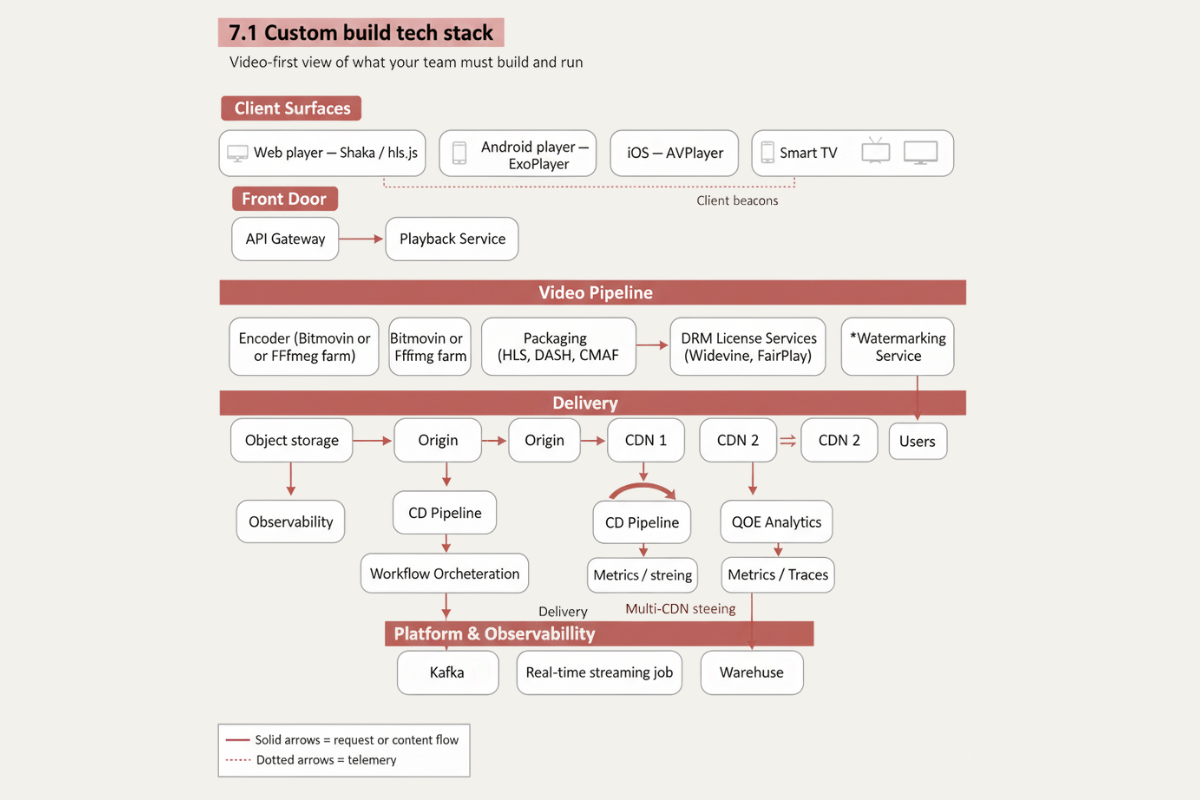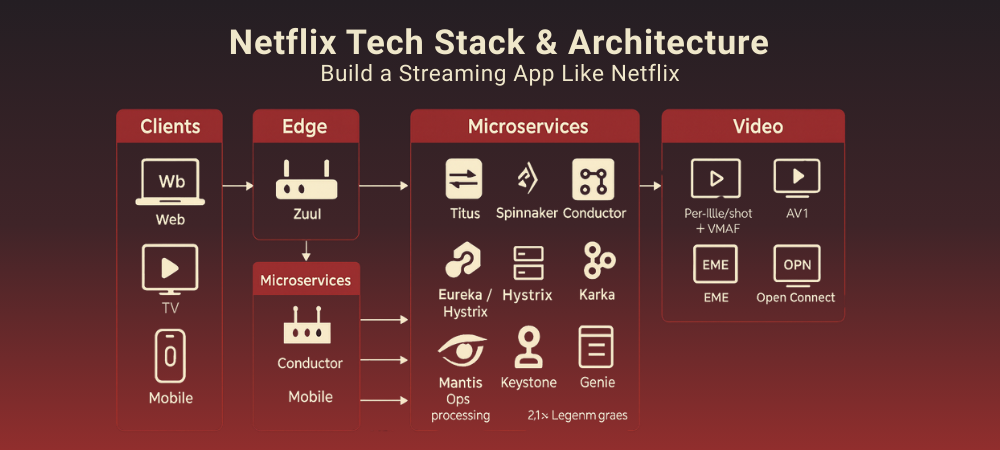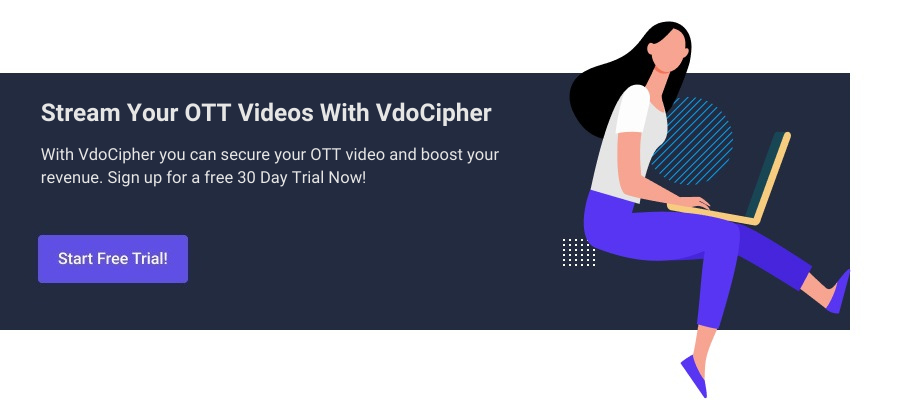This is a source-driven explainer of the Netflix tech stack and Netflix architecture. It summarizes what Netflix has publicly shared across client surfaces (React, Falcor or GraphQL), the edge (Zuul), the Netflix microservices architecture on AWS (Titus, Spinnaker), data and streaming platforms (EVCache, Cassandra, Mantis, Keystone), video pipeline and codecs (per-title and shot-based with VMAF, AV1), DRM with HTML5 EME, and the Netflix CDN, Open Connect. Every claim references an official source, and anything not disclosed is labeled “Not publicly documented,” with compact Netflix architecture diagram callouts for orientation.
TL;DR
Cloud and runtime – Netflix completed its AWS migration in 2016 and runs thousands of services in containers on Titus, with global CD through Spinnaker.
Clients – Web uses React with SSR optimizations, Falcor powered data fetching historically, GraphQL with the DGS framework is used broadly today. Consumer mobile UI framework is not comprehensively published, Studio apps share logic via Kotlin Multiplatform.
Video – Per-title then shot-based encoding guided by VMAF, AV1 on supported TVs, HTML5 EME on the web, delivery over Netflix Open Connect.
Edge and identity – Zuul and Zuul 2 sit in front of device APIs, with edge authentication and token-agnostic identity propagation.
Not public – Precise internal schemas, device-by-device DRM vendor mapping, cost models, and some operational playbooks.
Table of Contents:
- 1) Client Surfaces and Data Fetching (Netflix Tech Stack, client layer)
- 2) Edge and API Gateway (Netflix architecture at the edge)
- 3) Core Services and Orchestration (Netflix microservices architecture)
- 4) Data Layer and Caching in the Netflix Tech Stack
- 5) Video Pipeline, Encoding, DRM, and Delivery (Netflix CDN and Open Connect)
- 6) Reliability, Observability, and Testing
- 7) How to Build a Netflix-Grade Streaming Architecture in 2025 (from microservices at Netflix to your stack)
- FAQs
1) Client Surfaces and Data Fetching (Netflix Tech Stack, client layer)
Web – Netflix adopted React for netflix.com and documented performance wins from server and client rendering optimizations.
Mobile and TV – Netflix has discussed Falcor on Android historically and later GraphQL for services via the DGS framework. Consumer app UI framework details are not comprehensively published. Studio mobile apps share business logic with Kotlin Multiplatform.
Falcor vs GraphQL at Netflix – Falcor powered multiple member UIs historically. GraphQL adoption is public via Netflix’s DGS framework for building GraphQL services on Spring Boot. Studio and platform teams reference GraphQL with DGS, while Falcor remains documented in legacy posts.
| Device surface | Publicly documented approach | Source |
|---|---|---|
| Web (member UI) | React with server and client rendering optimizations | techblog.netflix.com |
| Android (consumer) | Historical Falcor usage noted, current consumer UI framework not comprehensively published | techblog.netflix.com |
| iOS (consumer) | Not publicly documented | Not publicly documented |
| TV devices | React use documented at Netflix, custom renderers referenced historically, specifics not centralized | netflixtechblog |
| Studio mobile (Android + iOS) | Kotlin Multi-platform for shared business logic | |
| Data fetching | Falcor historically, GraphQL services using DGS today | netflixtechblog |
Explore More ✅
VdoCipher helps over 3000+ customers from over 120+ countries to host their OTT videos securely, helping them to boost their video revenues.
2) Edge and API Gateway (Netflix architecture at the edge)
Zuul at the edge – Zuul fronts device APIs. Zuul 2 re-architected the gateway on Netty for asynchronous, non-blocking I/O and persistent connections at high scale.
Identity at the edge – Netflix documented edge authentication and token-agnostic identity propagation, decoupling device tokens from internal identity formats while maintaining cryptographic guarantees.
| Edge component | Role | Source |
|---|---|---|
| Zuul | API gateway in front of device APIs, routing and protection | techblog.netflix.com |
| Zuul 2 | Netty-based async gateway for high throughput and long-lived connections | techblog.netflix.com |
| Edge auth | Token-agnostic identity propagation from the edge into services | netflixtechblog.com |
3) Core Services and Orchestration (Netflix microservices architecture)
Containers and runtime – Netflix runs containers on Titus, its internal container platform open sourced in 2018.
Service discovery and resilience – Netflix publicly documented Eureka for service discovery, and Hystrix for latency and fault tolerance.
Global CD – Spinnaker enables multi-region continuous delivery, introduced and documented by Netflix.
Workflows – Conductor orchestrates microservice workflows.
| Runtime or platform | What it does | Source |
|---|---|---|
| Titus | Container management and execution platform at Netflix | netflixtechblog.com |
| Eureka | REST-based service discovery in AWS | techblog.netflix.com |
| Hystrix | Circuit breaking and latency tolerance (historical usage) | techblog.netflix.com |
| Spinnaker | Global continuous delivery | techblog.netflix.com |
| Conductor | Microservice workflow orchestration | techblog.netflix.com |
4) Data Layer and Caching in the Netflix Tech Stack
Caches and KV access – EVCache, a memcached-based system, is used for ephemeral, volatile caching. Netflix has also documented a Key-Value Data Abstraction Layer for standardizing access to backing stores like Cassandra.
Datastores – Cassandra appears frequently in Netflix posts and talks as a primary online store for scale-out workloads.
Real-time and batch – Mantis is the stream processing platform for operational telemetry. Keystone is the real-time data movement and processing backbone. Genie orchestrates big-data jobs.
| Data component | Workload | Source |
|---|---|---|
| EVCache | Low-latency ephemeral caching across regions | techblog.netflix.com |
| Cassandra | Durable online data store at large scale | netflixtechblog.com |
| KV Abstraction | Standardized access layer over key-value stores | netflixtechblog.com |
| Mantis | Real-time stream processing | techblog.netflix.com |
| Keystone | Real-time data pipeline | netflixtechblog.com |
| Genie | Big-data job orchestration | netflix.github.io |
5) Video Pipeline, Encoding, DRM, and Delivery (Netflix CDN and Open Connect)
Encoding – Netflix pioneered per-title encoding, later shipped optimized shot-based encodes, and measures perceptual quality with VMAF. AV1 streaming is enabled on supported TVs.
Web playback and DRM – Netflix publicly details its migration to HTML5 playback using MSE and EME across major browsers.
Delivery via Netflix Open Connect – Open Connect is Netflix’s own CDN, with Open Connect Appliances embedded at ISPs and at interconnect sites.
| Stage | Publicly stated Netflix approach | Source |
|---|---|---|
| Ingest | Not publicly documented | Not publicly documented |
| Transcode | Per-title, then per-shot optimization guided by perceptual metrics (VMAF) | techblog.netflix.com |
| Package | Not publicly documented | Not publicly documented |
| Protect | HTML5 playback via EME on web, platform DRMs per device | netflixtechblog.com |
| Deliver | Open Connect CDN program and overview documentation | openconnect.netflix.com |
6) Reliability, Observability, and Testing
Chaos engineering – Netflix created the Simian Army, extended with FIT for precise failure injection and ChAP for automated, guarded chaos experiments.
Telemetry – Atlas is Netflix’s primary dimensional time-series telemetry system, with streaming evaluation for alerting.
Adaptive concurrency – Netflix open-sourced concurrency-limits for adaptive concurrency control, a practical load-shedding primitive.
Canary analysis – Kayenta provides automated canary analysis in the deployment workflow.
| Practice or tool | What it solves | Source |
|---|---|---|
| Simian Army | Fault tolerance testing through controlled failure | techblog.netflix.com |
| FIT | Precise failure injection for services and requests | netflixtechblog.com |
| ChAP | Automated chaos experiments with guardrails | netflixtechblog.com |
| Atlas | High-scale metrics and near real-time ops insight | techblog.netflix.com |
| concurrency-limits | Adaptive concurrency and load shedding | github.com |
| Kayenta | Automated canary analysis | netflixtechblog.com |
7) How to Build a Netflix-Grade Streaming Architecture in 2025 (from microservices at Netflix to your stack)
This section turns Netflix’s public architecture into a buildable blueprint. It shows the effort required if you assemble the stack yourself, then also shows development architecture with ready to use SaaS like VdoCipher.
7.1 Custom build streaming app tech stack (Heavy Tech Load)
 You own and operate every moving part end-to-end. Typical build list:
You own and operate every moving part end-to-end. Typical build list:
- Encoding and packaging – Create encode presets, run per-title analysis, build CMAF HLS and DASH pipelines, define ABR ladders and quality gates using VMAF, and regression test startup and seek performance across your device matrix.
- DRM – Deploy and operate license services for Widevine and FairPlay with key rotation, TTLs, device rules, and audit trails.
- Playback security. Build tokenized one-time playback, domain and geo restriction, concurrency/session controls, and dynamic visible watermarking tied to user or session.
- Delivery – Stand up storage and origin, select one or more CDNs, tune cache keys and signed URLs, and add multi-CDN steering and failover.
- Players – Integrate EME on web, ExoPlayer on Android, and AVPlayer on iOS with vendor-specific quirks, fallback renderers, and subtitle pipelines.
- QoE and operations – Instrument client and server, capture error taxonomies, track license p95 latency and rebuffers, define SLOs, alerts, runbooks, and rollback plans.
This path maximizes flexibility but demands a dedicated video, security, and SRE team to achieve Netflix architecture-level reliability.
7.2 Build Streaming App Faster with VdoCipher: Secured video hosting & DRM (Recommended)
If your priority is speed, strong DRM, and lower ops overhead, VdoCipher compresses months of platform work into an SDK and managed service.
- Multi-DRM and keys – Widevine and FairPlay license services, key generation and rotation, policy controls.
- Secure playback – Tokenized one-time playback, domain or geo restriction, session or concurrency limits, dynamic visible watermarking.
- Packaging and delivery – Managed storage and packaging with production-ready delivery using built-in AWS CloudFront. No extra CDN is required.
- Client SDKs and players – Web SDK for Shaka/hls.js, Android SDK with ExoPlayer, iOS SDK with AVPlayer, TV integration guidance.
- Analytics – QoE dashboards and piracy signals included.
What you still own: device QA matrix, ABR ladder targets, QoE and incident runbooks.
Read More: History of Netflix- Founding, Model, Timeline, Milestones
FAQs
1) What is the Netflix architecture?
The Netflix architecture is a cloud-native design on AWS that prioritizes resiliency and scale. It uses an edge gateway (Zuul), a microservices core, container orchestration (Titus), automated delivery (Spinnaker), and a data platform built around streaming pipelines and resilient storage.
2) Is Netflix a microservices architecture?
Yes. Netflix runs thousands of independently deployable services, each owning a narrow capability, with client-side resilience patterns, service discovery, and automated continuous delivery. This is often referred to as Netflix microservices.
3) What is the Netflix CDN?
The Netflix CDN is Open Connect, Netflix’s own content delivery network. It moves content as close as possible to viewers by placing Netflix caching servers with ISPs and at major interconnects to minimize latency and transit costs.
4) How does Netflix deliver video at scale with Open Connect?
Encoded assets are pushed to OCAs during off-peak “fill windows.” During playback the client fetches manifests and segments from the nearest OCA, falling back to other locations when needed. This architecture underpins search queries like “Netflix CDN” and “Netflix Open Connect.”
5) What sits at the edge of the Netflix architecture?
Zuul and Zuul 2 act as the programmable edge, handling routing, auth, and connection management in front of device APIs. Identity is validated at the edge and propagated internally in a token-agnostic way.
Ship Secure Streaming App Faster with VdoCipher
Multi-DRM (Widevine, FairPlay), built-in AWS CloudFront CDN, client SDKs for web/Android/iOS, dynamic watermarking, and Advanced analytics out of the box.


Leading Growth at VdoCipher. I love building connections that help businesses grow and protect their revenue. Outside of work, I’m always exploring new technology and startups.



Leave a Reply